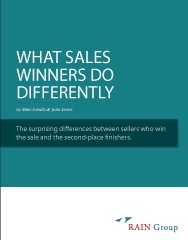Giving Prospects the Confidence to Hire You
When it comes to selling – many of us focus on our fears.
“Will they buy?”
“Are my services priced right?”
“What are they looking for?”
“Will they go with me?”
These questions inevitably lead to a dance that involves both buyer and seller, a delicate tip-toeing around the heart of the matter. We try to talk about needs, solutions, benefits, values.
But a buyer is not looking for those things alone. Above all else, a buyer is looking to feel confident that they made the right decision; that their business or needs are in the right hands.
Are you giving your prospects the CONFIDENCE to hire you?
——–
A western journalist visiting the old Soviet Union, so the story goes, asked a worker if he was being paid well. The worker said, “It’s all pretend. We pretend to work and they pretend to pay us.”
Do you sell consulting? IT services? Accounting? Financial planning? Legal services? Then you too play a game of pretend – with your would-be clients. They pretend to care about your qualifications. You pretend to listen to their questions. You pretend to write a unique proposal. They pretend to read it. You pretend to sell. They pretend to buy.
All the while, behind the game of pretending, an unspoken and important vetting process is taking place.
For example, a company about to spend big on a CRM system, or make an investment in leadership training, or change its sales approach, will ask about the benefits of what’s being sold. The prospect will want to know the answer and they will pretend it matters most.
But what they really want to know is – will we have the confidence to sleep well at night given the choice we make?
And yet, this search for confidence – the thing that matters most – isn’t what’s actually discussed during the sales process.
Instead, prospective clients have been seduced by the trappings of “hard business.” They think “if you can’t measure it, you can’t manage it,” and they try to reduce decisions to metrics. That’s how we end up with clients wanting to know all about our qualifications – despite the fact that our qualifications were what already got us in the room in the first place.
And so, we all pretend that buying and selling is about talking. About words and numbers. About qualifications.
But it’s not. The fact is, clients make huge, complex, intangible decisions very much on the basis of gut, emotion, feeling, opinion, Kentucky windage, call it what you will.
As sales guru Jeffrey Gitomer says, people buy with the heart, and justify with the brain. It’s not about rational decisions, but about decisions rationalized.
The truth is this: people vastly prefer to buy what they need from people they feel good about. People they trust. People who they believe have their clients’ interests at heart, not just their own. People who make an effort to honestly listen to their clients. People who actually seem to care.
This goes beyond “people buy from people they like,” or “people buy from people similar to themselves.” It’s way more than schmoozing and finding out common interests.
It gets to the guts of the matter:
- Do you actually seem to give a damn about me?
- Do you act like you care about me?
- Are you working your own agenda, or will you actually listen to mine?
Sales process designs won’t get you there. Metrics and CRM systems won’t get you there. Motivational speeches won’t get you there.
But two things will.
1. Genuine, Honest-to-Goodness Listening
That’s listening for real. Listening not to find out data, but to find out about the client. Listening not to make or confirm a hypothesis, but to understand another human being. Listening not to find out client needs, but to find out what makes a business and a person tick. Listening not so you get answers, but listening so that at the end of it, the other fellow feels heard. Listening not to provide great answers, but listening to earn the right to offer those answers later.
I’ve heard this called yellow-pad listening; no proposal or talking points in front of you, just a blank pad ready to take notes if necessary as issues come up. Whatever you call it, remember another old truism that is still true: People don’t care what you know until they know that you care.
2. Sample Selling
People don’t buy ice cream from verbal descriptions; they buy it from taste. Referrals may get people in the door, but samples sell them. We don’t use samples selling nearly enough when it comes to selling the intangible.
Give people a taste of what you do. Assume you’ve got the job, and start working it in the early stages. Don’t say how good you are at tax planning, grab hold of some business issues and show them how you do it — on their data.
If a voice in the back of your mind (or your boss in the front) says, “don’t give it away,” recognize that they are wrong. There is an inexhaustible supply of problems in this world. Giving away a few solutions doesn’t diminish your value — it earns you the right to solve more of those problems.
If a client shows a pattern of stealing ideas from you, quietly drop them. After all, that’s the kind of client you’d prefer your competitors to have. Place your focus instead on those clients who want relationships of mutual benefit.
* * *
Listening and sample selling. These are actions, not thoughts. Deeds, not qualifications. Results, not process designs. Most of all, they demonstrate your devotion to your client.
After all, would you rather buy from someone who says, “Trust me”? Or, from someone who shows you why you should?



 You know the old line, “If you’ve got a hammer, everything looks like a nail.” It means we tend to see the world through our own frames of reference. It’s a good reminder to watch out for unconscious biases. And in sales, it shows up in a very particular way.
You know the old line, “If you’ve got a hammer, everything looks like a nail.” It means we tend to see the world through our own frames of reference. It’s a good reminder to watch out for unconscious biases. And in sales, it shows up in a very particular way. The biggest problem in sales? Violating the laws of human nature.
The biggest problem in sales? Violating the laws of human nature. In an episode of
In an episode of